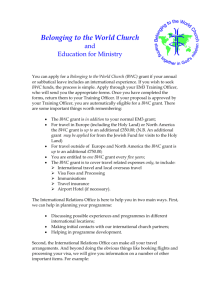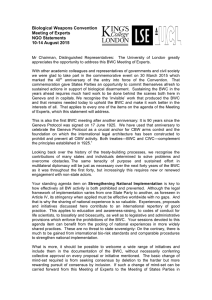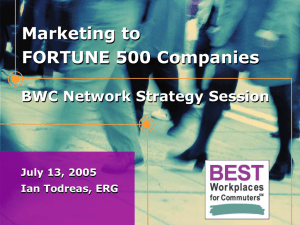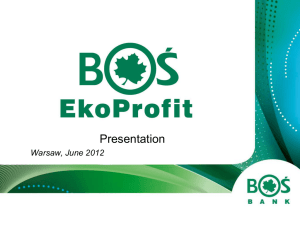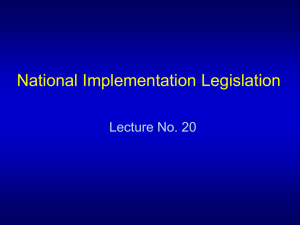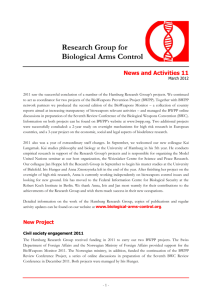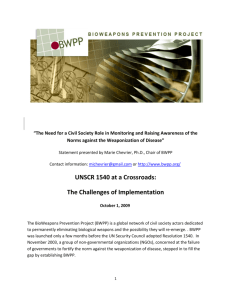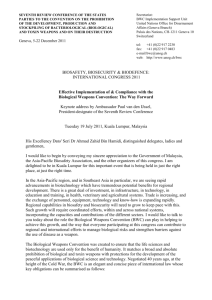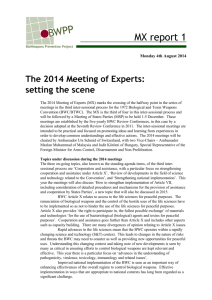Biochemical Security 2030: S&T at the BTWC
advertisement
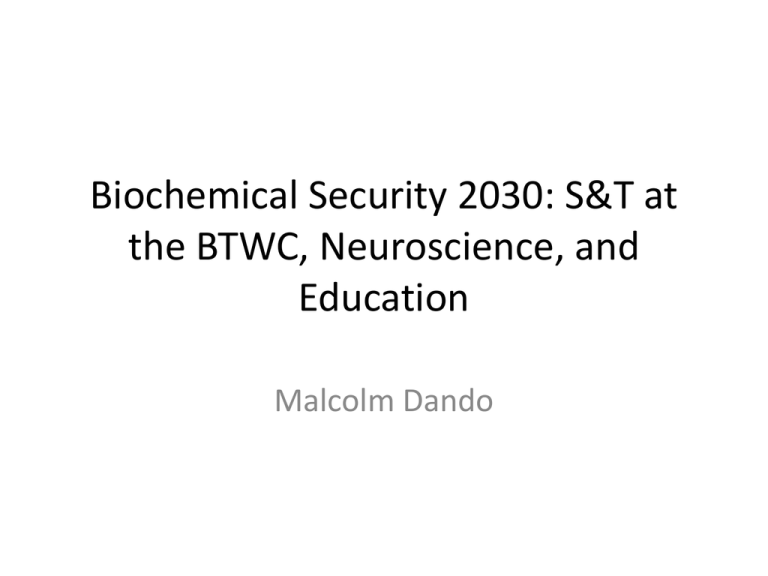
Biochemical Security 2030: S&T at the BTWC, Neuroscience, and Education Malcolm Dando OUTLINE • Section A: Research Questions/Briefing Papers – Slides 1 - 4 • Section B: Ideas and Outcomes in the ISP – Slides 5 - 10 • Section C: Why the Failure of the ISP? – Slides 11 - 14 • Section D: Conclusion – Slides 15 - 20 A1. Research Question 1: S&T at the BTWC • How are the risks stemming from S&T assessed and addressed in the two CBW regimes? • Briefing Paper 6: An analysis of the S&T deliverables agreed by BWC State Parties at the end of 2013. • LATE 2013. A2. Research Question 2: Neuroscience • What are the plausible trajectories of the three key S&T areas…[including] neuroscience …and how are the security implications of these interpreted by different groups? • Briefing Paper 10: differing perceptions of neuroscience, its societal implications and potential for international cooperation. • SUMMER 2014. A3. Research Question 4: Education of Scientists • How can current multilateral practice be improved by transition to a science-based multilateral governance that takes account of different institutional, cultural, historical and other social factors? • Briefing Paper 12: How can implementation of the BWC be improved so that effective action can be taken to more effectively develop awareness, education and…any necessary measures… • SUMMER 2014 B5. Related Work • Kelle, A., Nixdorff, K. and Dando, M.R. (2013) Science and Technology in the Third BWC Intersessional Process: Conceptual Considerations and the 2012 ISP Meetings. University of Bath. • Nixdorff, K. Interviews at the 2013 Meeting of Experts. • Chan, S. et al (2013) AHRC UK Neuroethics Network. B6. Objectives of the SAI on Science and Technology • United States, Developments in Science and Technology, BWC/MSP/2012/MX/WP.6: – “While the agenda item consists of a number of sub-items, it has two major elements. The first is a review of S&T developments potentially relevant to the BWC….The second addresses how such developments should be managed – questions of national oversight, scientific responsibility, outreach and education...” B7. Action Orientation • United Kingdom, Decision-Making in a future BTWC intersessional work programme, BWC/CONF.VII/WP.10: – “…we argue that future expert and State Party meetings should be able to make decisions of an appropriate nature to ensure that ‘effective action’ is taken on those issues where there is clearly consensus that this is a proper course to take…” B8. Effective Processes • Australia, Japan and New Zealand, Proposal for the annual review of advances in science and technology relevant to the Biological Weapons Convention, BWC/CONF.VII/WP.13: – “The S&T Working Group Facilitator’s Report would be circulated prior to the subsequent MSP to allow States Parties to consider any actions required. Actions taken by the MSP relevant to the implementation and operation of the BWC arising from the S&T Working Group would be subject to review at the subsequent Review Conference…” B9. The ISU • Germany, BWC/CONF.VII/WP.15: – “The Intersessional Bureau should consist of representatives from the regional groups, including the group coordinators, the three depositaries and the designate chairman as members and the head of the ISU as its secretary. Two or three sessions before the MXP would be ideal…” • South Africa, BWC/CONF.VII/WP.17: – “…The ISU structure and budget should be based on proper planning once there is consensus on its role and functions…” B10. The Outcome in 2012 • South Africa, The intersessional process: comments and proposals, BWC/MSP/2012/WP.7: – “Some excellent presentations were given by experts in which very complicated scientific issues were explained in simple terms. However, there was no substantive engagement on these presentations and therefore, opportunities to come to useful common understandings were lost. A number of very useful discussions took place during lunchtime side events, but they were not attended by all delegations or part of the formal MXP.” C 11 . Noel-Baker, 1979 • Preface to The First World Disarmament Conference 1932-33: And Why it Failed: – “…the purpose of this historical outline is to show that international disarmament negotiations have not failed because of any inherent technical difficulty in drawing up the necessary Treaty; they have failed because men in positions of authority or influence have wanted them to fail, and have striven successfully to make them do so.” C12. Alva Myrdal, 1976 • Preface to The Game of Disarmament: How the United States and Russia run the Arms Race: – “This book is an attempt to study the policy questions of disarmament from an international point of view. It has grown out of a gradually increasing feeling of near despair after twelve years of participating in multilateral disarmament negotiations. There the superpowers have indulged in subterfuges and halftruths, with their closest and usually dependent allies following suit or keeping silent. On balance, there has been no real advance towards limitation of armaments….The militarization of the economy and national life of almost all countries has intensified.” C13. China, India, Iran, Pakistan, Russia (i) • Draft Proposal on structure of ISP (Section B1 of BWC/CONF.VII/CRP.1): – “6. The annual meetings of State Parties will discuss and promote common understandings on the following agenda items to be considered in all Meetings of the State Parties: – a) Review of developments in the field of science and technology related to the Convention.” C14. China, India, Iran, Pakistan, Russia (ii) – “9. Each meeting of the States Parties will be prepared by a one-week meeting of experts… – 10. The meeting of experts will prepare a factual report describing their work, which will be discussed by the annual meeting of States Parties… – 12. All meetings, both of experts and of States Parties, will work on the basis of consensus. – 13. The work and outcome of the annual meetings of States Parties will be considered by the Eighth Review Conference.” D15. Conclusions (i) • Given the structure and organisation of the ISP, and therefore the SAI on Science and Technology, it is no great surprise that no useful practical actions have been agreed so far. • This outcome was not the result of unfortunate accident, but the deliberate choice of some powerful delegations. • It is unlikely that any significant change in the structure and organisation of the ISP will be possible before 2016. D16. Conclusions (ii) • Imaginative ways will have to be found to get around the blockage on effective actions being taken through the ISP. • For example, progressive State Parties and Civil Society can carry out projects to develop and implement best practices in key areas such as education and report them in side events that are then fed back into the MXP/MSP so that other concerned State Parties can copy and develop these models - and actually get something done on the ground around the world. D17. Side Event BTWC MXP, 2013 (i) • Ambassador Urs Schmid: Introduction – “Life sciences and corresponding technologies have been experiencing exponential growth over the past years and brought extraordinary advances in healthcare. At the same time, they are also accompanied by unprecedented threats to biosecurity as the same knowledge and technologies can be misused to cause harm. The dual-use nature of life science research therefore requires awareness-raising among life scientists of the potential dangers linked to their work and the promotion of a culture of responsibility. Biosecurity education constitutes a crucial element for achieving responsible conduct of research and that is an important measure for the implementation of the Biological Weapons Convention”. D18. Side Event BTWC MXP, 2013 (ii) Ambassador Urs Schmid: Introduction – “The crucial role life scientists play in the prevention of misuse of biotechnology and the important role of education and awareness-raising have been recognized in successive Review Conferences of the Biological Weapons Convention. The centrality of this issue was confirmed by the the 7th Review Conference which decided that “education and awareness-raising about risks and benefits of life sciences and biotechnology” under the Standing Agenda Item “review of developments in the field of science and technology related to the Convention” would be addressed at the meetings of the intersessional programme every year from 2012 – 2015”. D19. Side Event BTWC MXP, 2013 (iii) Ambassador Urs Schmid: Conclusion “It is clear that the education of life scientists about the Biological Weapons Convention and the responsibilities they have under that convention needs our continued attention and requires further efforts. Important deficits still exists today in this area, as highlighted by several speakers. In this context, a variety of projects have demonstrated that the biosecurity education of life scientists and associated scientists can be improved by a number of methods that have been implemented successfully, as demonstrated in the presentations this morning”. D20. Side Event BTWC MXP, 2013 (iv) Ambassador Urs Schmid: Conclusion “Finally, and this is probably a central element that I retain from this side-event, is that a coherent long-term coordinated effort by States is required to implement biosecurity education at a number of levels. It is also important that States Parties report on their efforts to meetings of the Biological Weapons Convention, both to facilitate the development of best practice in biosecurity education and to increase confidence in compliance. In this context, it would be desirable that common understandings could be developed in the BWC intersessional process on the issue of implementing biosecurity education nationally, and that specific action would be adopted in this respect”.
